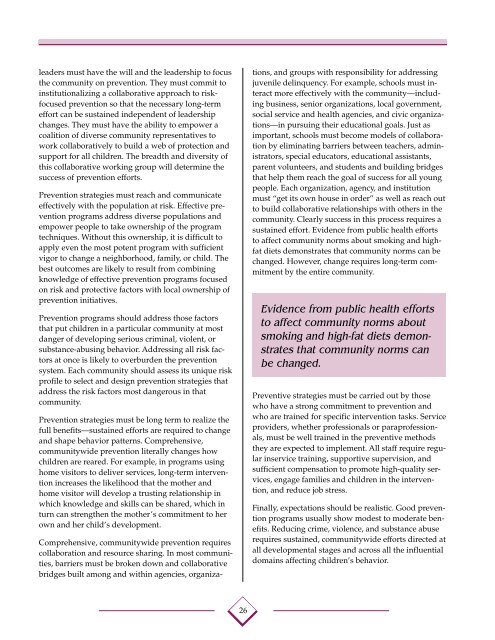uide for Implementing the Comprehensive Strategy for Serious ...
uide for Implementing the Comprehensive Strategy for Serious ...
uide for Implementing the Comprehensive Strategy for Serious ...
Create successful ePaper yourself
Turn your PDF publications into a flip-book with our unique Google optimized e-Paper software.
leaders must have <strong>the</strong> will and <strong>the</strong> leadership to focus<br />
<strong>the</strong> community on prevention. They must commit to<br />
institutionalizing a collaborative approach to riskfocused<br />
prevention so that <strong>the</strong> necessary long-term<br />
ef<strong>for</strong>t can be sustained independent of leadership<br />
changes. They must have <strong>the</strong> ability to empower a<br />
coalition of diverse community representatives to<br />
work collaboratively to build a web of protection and<br />
support <strong>for</strong> all children. The breadth and diversity of<br />
this collaborative working group will determine <strong>the</strong><br />
success of prevention ef<strong>for</strong>ts.<br />
Prevention strategies must reach and communicate<br />
effectively with <strong>the</strong> population at risk. Effective prevention<br />
programs address diverse populations and<br />
empower people to take ownership of <strong>the</strong> program<br />
techniques. Without this ownership, it is difficult to<br />
apply even <strong>the</strong> most potent program with sufficient<br />
vigor to change a neighborhood, family, or child. The<br />
best outcomes are likely to result from combining<br />
knowledge of effective prevention programs focused<br />
on risk and protective factors with local ownership of<br />
prevention initiatives.<br />
Prevention programs should address those factors<br />
that put children in a particular community at most<br />
danger of developing serious criminal, violent, or<br />
substance-abusing behavior. Addressing all risk factors<br />
at once is likely to overburden <strong>the</strong> prevention<br />
system. Each community should assess its unique risk<br />
profile to select and design prevention strategies that<br />
address <strong>the</strong> risk factors most dangerous in that<br />
community.<br />
Prevention strategies must be long term to realize <strong>the</strong><br />
full benefits—sustained ef<strong>for</strong>ts are required to change<br />
and shape behavior patterns. <strong>Comprehensive</strong>,<br />
communitywide prevention literally changes how<br />
children are reared. For example, in programs using<br />
home visitors to deliver services, long-term intervention<br />
increases <strong>the</strong> likelihood that <strong>the</strong> mo<strong>the</strong>r and<br />
home visitor will develop a trusting relationship in<br />
which knowledge and skills can be shared, which in<br />
turn can streng<strong>the</strong>n <strong>the</strong> mo<strong>the</strong>r’s commitment to her<br />
own and her child’s development.<br />
<strong>Comprehensive</strong>, communitywide prevention requires<br />
collaboration and resource sharing. In most communities,<br />
barriers must be broken down and collaborative<br />
bridges built among and within agencies, organiza-<br />
26<br />
tions, and groups with responsibility <strong>for</strong> addressing<br />
juvenile delinquency. For example, schools must interact<br />
more effectively with <strong>the</strong> community—including<br />
business, senior organizations, local government,<br />
social service and health agencies, and civic organizations—in<br />
pursuing <strong>the</strong>ir educational goals. Just as<br />
important, schools must become models of collaboration<br />
by eliminating barriers between teachers, administrators,<br />
special educators, educational assistants,<br />
parent volunteers, and students and building bridges<br />
that help <strong>the</strong>m reach <strong>the</strong> goal of success <strong>for</strong> all young<br />
people. Each organization, agency, and institution<br />
must “get its own house in order” as well as reach out<br />
to build collaborative relationships with o<strong>the</strong>rs in <strong>the</strong><br />
community. Clearly success in this process requires a<br />
sustained ef<strong>for</strong>t. Evidence from public health ef<strong>for</strong>ts<br />
to affect community norms about smoking and highfat<br />
diets demonstrates that community norms can be<br />
changed. However, change requires long-term commitment<br />
by <strong>the</strong> entire community.<br />
Evidence from public health ef<strong>for</strong>ts<br />
to affect community norms about<br />
smoking and high-fat diets demonstrates<br />
that community norms can<br />
be changed.<br />
Preventive strategies must be carried out by those<br />
who have a strong commitment to prevention and<br />
who are trained <strong>for</strong> specific intervention tasks. Service<br />
providers, whe<strong>the</strong>r professionals or paraprofessionals,<br />
must be well trained in <strong>the</strong> preventive methods<br />
<strong>the</strong>y are expected to implement. All staff require regular<br />
inservice training, supportive supervision, and<br />
sufficient compensation to promote high-quality services,<br />
engage families and children in <strong>the</strong> intervention,<br />
and reduce job stress.<br />
Finally, expectations should be realistic. Good prevention<br />
programs usually show modest to moderate benefits.<br />
Reducing crime, violence, and substance abuse<br />
requires sustained, communitywide ef<strong>for</strong>ts directed at<br />
all developmental stages and across all <strong>the</strong> influential<br />
domains affecting children’s behavior.

















